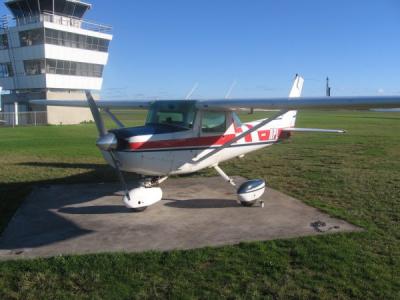Cessna A152, ZK-NPL and Robinson R22 Beta, ZK-HIE near-collision New Plymouth Aerodrome 10 May 2010
Status
Closed
Occurrence Date
Report Publication Date
Jurisdiction
NZ
Legacy Inquiry Number
10-005
On 10 May 2010, a light helicopter and a light aeroplane, both of which were being used for dual pilot training, had a near-collision overhead New Plymouth Aerodrome.
The pilots of both aircraft were operating under VFR and in accordance with their respective ATC clearances. The aeroplane was descending from overhead using the standard circuit joining procedure for a left-hand circuit for runway 14, the runway in use, whereas the helicopter was operating above the normal circuit altitude in a right-hand circuit for the same runway. The aeroplane descended through the downwind leg of the helicopter’s circuit.
The Transport Accident Investigation Commission (the Commission) made the following findings:
+ the air traffic controller’s (the controller’s) instructions were valid for Class D airspace, but he did not manage the increased risk of collision presented by the aeroplane descending to circuit altitude in the opposite direction
+ the aviation community, including the regulator, Airways Corporation of New Zealand Limited (Airways), aerodrome operators and aircraft operators, does not have a consistent approach to reducing the collision risks associated with simultaneous opposed circuits at aerodromes
+ Civil Aviation Rule 91.223 can be interpreted ambiguously in non-standard traffic situations, which could contribute to the collision risk at aerodromes
+ the descriptions of and requirements for the standard overhead circuit joining procedure that are published in Civil Aviation Rules, the Aeronautical Information Publication New Zealand (Aeronautical Information Publication) and the Flight Instructor’s Guide can be misinterpreted or misapplied in non-standard traffic situations. This could contribute to the collision risk at aerodromes
+ the controller recognised the potential for a conflict, but he provided traffic information to the pilots of the aeroplane only, and not to the pilots of the helicopter
+ the incident would not have occurred had either of the aeroplane pilots stopped the descent when he lost sight of the helicopter
+ the incident would have been less likely to occur had the aeroplane pilots immediately broadcast that they had lost sight of the helicopter
+ local aerodrome user groups benefit their participants by providing information about their respective activities. Aerodrome operators, in order to manage their operational risks, should require their relevant tenants and users to participate fully in such groups
+ the see-and-avoid principle continues to have relevance, provided pilots and controllers counter its well-known limitations by the appropriate sharing of traffic information
+ some VFR pilots continue to misconstrue ATC traffic information and instructions in Class C and D airspace as the provision of traffic separation.
The Commission made the following recommendation:
That the Director of Civil Aviation takes action to address the following safety issues:
+ the aviation community, including the regulator, Airways, aerodrome operators and aircraft operators, does not have a consistent approach to reducing the collision risks associated with simultaneous opposed circuits at aerodromes. Simultaneous opposed circuits can exist as a result of locally agreed procedures at uncontrolled aerodromes, and also at controlled aerodromes under some conditions
+ ATC, having cleared an aircraft to make a non-standard circuit, is not prevented from concurrently clearing a following aircraft to join the circuit by the standard overhead joining procedure, even though that could lead to a head-on traffic conflict
+ the descriptions of and requirements for the standard overhead circuit joining procedure that are published in the Civil Aviation Rules, the Aeronautical Information Publication and the Flight Instructor’s Guide can be misinterpreted or misapplied, particularly if a preceding aircraft is operating in a non-standard circuit, which could contribute to the collision risk at aerodromes
+ in controlled airspace where separation is not provided between aircraft operating under VFR, a VFR aircraft that is instructed to follow another aircraft is not explicitly required to advise ATC promptly if visual contact is lost with the relevant traffic
+the present voluntary and informal nature of aerodrome user groups restricts their potential for improving operational safety at aerodromes.
The key lessons from the inquiry into this occurrence were:
+ the aviation community must take concerted and consistent action to reduce the collision risk associated with simultaneous opposed circuits at aerodromes
+ controllers must be alert to situations that warrant the issuing of mutual traffic information
+ to minimise the risk of collision, pilots must combine an effective look-out with an attentive radio listen-out, especially in the vicinity of aerodromes
+ pilots should advise, by broadcast if appropriate, when relevant traffic is no longer in sight and take any necessary action to ensure the safety of their flights
+ the see-and-avoid principle continues to have relevance, provided pilots and controllers counter its well-known limitations by the appropriate sharing of traffic information
+ Civil Aviation Rules and Aeronautical Information Publications must be written carefully and explained clearly to students to avoid ambiguity
+ pilots must understand that, under most circumstances, ATC does not provide separation between VFR traffic in Class C and Class D airspace, even when clearances are issued
The pilots of both aircraft were operating under VFR and in accordance with their respective ATC clearances. The aeroplane was descending from overhead using the standard circuit joining procedure for a left-hand circuit for runway 14, the runway in use, whereas the helicopter was operating above the normal circuit altitude in a right-hand circuit for the same runway. The aeroplane descended through the downwind leg of the helicopter’s circuit.
The Transport Accident Investigation Commission (the Commission) made the following findings:
+ the air traffic controller’s (the controller’s) instructions were valid for Class D airspace, but he did not manage the increased risk of collision presented by the aeroplane descending to circuit altitude in the opposite direction
+ the aviation community, including the regulator, Airways Corporation of New Zealand Limited (Airways), aerodrome operators and aircraft operators, does not have a consistent approach to reducing the collision risks associated with simultaneous opposed circuits at aerodromes
+ Civil Aviation Rule 91.223 can be interpreted ambiguously in non-standard traffic situations, which could contribute to the collision risk at aerodromes
+ the descriptions of and requirements for the standard overhead circuit joining procedure that are published in Civil Aviation Rules, the Aeronautical Information Publication New Zealand (Aeronautical Information Publication) and the Flight Instructor’s Guide can be misinterpreted or misapplied in non-standard traffic situations. This could contribute to the collision risk at aerodromes
+ the controller recognised the potential for a conflict, but he provided traffic information to the pilots of the aeroplane only, and not to the pilots of the helicopter
+ the incident would not have occurred had either of the aeroplane pilots stopped the descent when he lost sight of the helicopter
+ the incident would have been less likely to occur had the aeroplane pilots immediately broadcast that they had lost sight of the helicopter
+ local aerodrome user groups benefit their participants by providing information about their respective activities. Aerodrome operators, in order to manage their operational risks, should require their relevant tenants and users to participate fully in such groups
+ the see-and-avoid principle continues to have relevance, provided pilots and controllers counter its well-known limitations by the appropriate sharing of traffic information
+ some VFR pilots continue to misconstrue ATC traffic information and instructions in Class C and D airspace as the provision of traffic separation.
The Commission made the following recommendation:
That the Director of Civil Aviation takes action to address the following safety issues:
+ the aviation community, including the regulator, Airways, aerodrome operators and aircraft operators, does not have a consistent approach to reducing the collision risks associated with simultaneous opposed circuits at aerodromes. Simultaneous opposed circuits can exist as a result of locally agreed procedures at uncontrolled aerodromes, and also at controlled aerodromes under some conditions
+ ATC, having cleared an aircraft to make a non-standard circuit, is not prevented from concurrently clearing a following aircraft to join the circuit by the standard overhead joining procedure, even though that could lead to a head-on traffic conflict
+ the descriptions of and requirements for the standard overhead circuit joining procedure that are published in the Civil Aviation Rules, the Aeronautical Information Publication and the Flight Instructor’s Guide can be misinterpreted or misapplied, particularly if a preceding aircraft is operating in a non-standard circuit, which could contribute to the collision risk at aerodromes
+ in controlled airspace where separation is not provided between aircraft operating under VFR, a VFR aircraft that is instructed to follow another aircraft is not explicitly required to advise ATC promptly if visual contact is lost with the relevant traffic
+the present voluntary and informal nature of aerodrome user groups restricts their potential for improving operational safety at aerodromes.
The key lessons from the inquiry into this occurrence were:
+ the aviation community must take concerted and consistent action to reduce the collision risk associated with simultaneous opposed circuits at aerodromes
+ controllers must be alert to situations that warrant the issuing of mutual traffic information
+ to minimise the risk of collision, pilots must combine an effective look-out with an attentive radio listen-out, especially in the vicinity of aerodromes
+ pilots should advise, by broadcast if appropriate, when relevant traffic is no longer in sight and take any necessary action to ensure the safety of their flights
+ the see-and-avoid principle continues to have relevance, provided pilots and controllers counter its well-known limitations by the appropriate sharing of traffic information
+ Civil Aviation Rules and Aeronautical Information Publications must be written carefully and explained clearly to students to avoid ambiguity
+ pilots must understand that, under most circumstances, ATC does not provide separation between VFR traffic in Class C and Class D airspace, even when clearances are issued
Location
New Plymouth Aerodrome (-39.008313,174.178362) [may be approximate]

